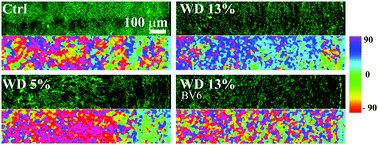Adaptive reorientation of endothelial collectives in response to strain†
Abstract
Mature epithelial monolayers share the ability to coherently respond to external mechanical stimuli. Tissue remodeling requires cell shape changes and coordinated movements. Human endothelia provide an exquisite example of such emerging collective activities. As part of their function in maintaining body homeostasis under variable hemodynamic loadings, endothelial ensembles must dynamically adapt to wall shear stress and cyclic deformation. While the alignment of several types of cells, including fibroblasts, osteoblasts and epithelial tissues, in response to various flow conditions or wall shear stress levels has been described in detail, less is known about collective endothelial remodeling under pure wall deformation. Here, using a custom-developed bioreactor, we exposed mature human endothelia to two distinct physiological levels of cyclic loading, generating overlapping gradients of strain. Endothelial cells remodeled depending on the level of imposed strain yielding local variations of cell density. In particular, a collective cell orientation orthogonal to the main direction of strain was observed at low levels of wall deformation, while cells reoriented parallel to the main direction of strain at high levels of wall deformation. The tissue adaptation depended on the establishment of mature adherens junctions, which were reinforced by the polarized recruitment of the adaptor protein vinculin. The pivotal role of cell-to-cell junctions was confirmed by the biochemical inhibition of vascular endothelial cadherin homotypic contacts, which impaired the collective remodeling. Together, our data establish wall deformation as an independent determinant of endothelial architecture with direct implications in vascular physiopathology.



 Please wait while we load your content...
Please wait while we load your content...